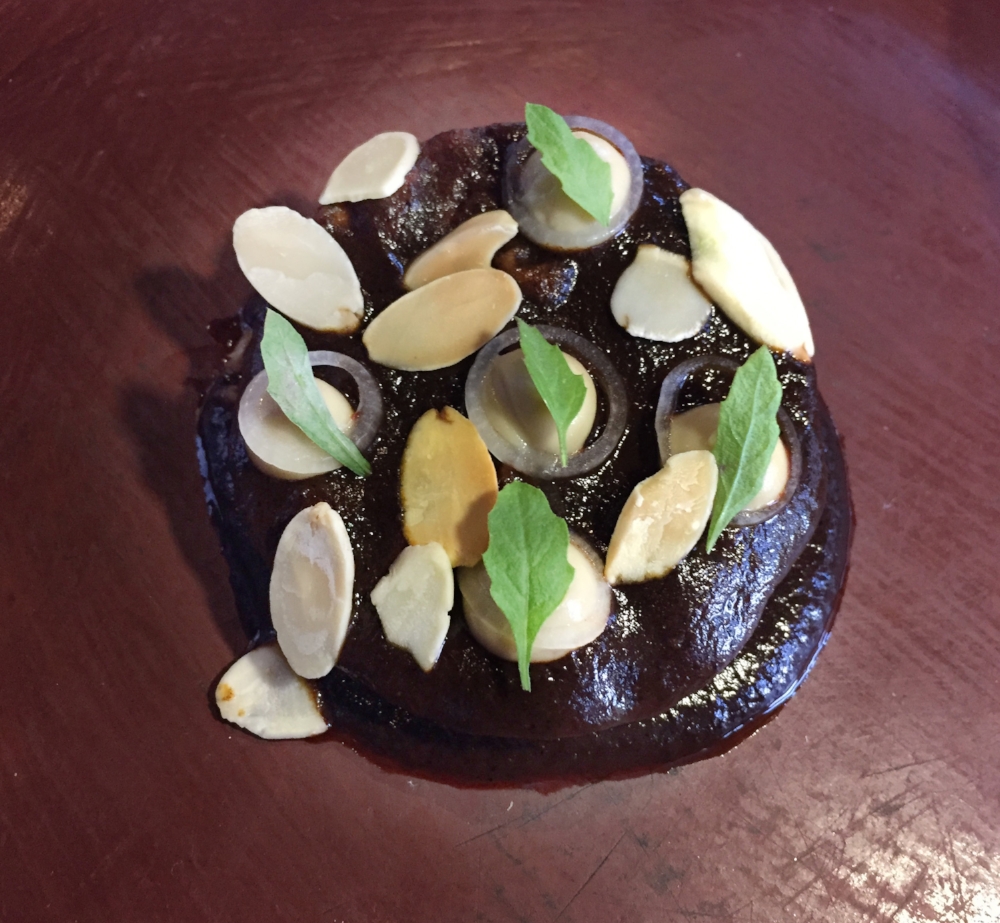Out of town: Evoka, Francisco Molina & Tlaxcala
For urbanites like me there’s always something unnerving about traversing the city’s limits. Familiarity, albeit of the mind-assaulting megalopolitan variety is immoderately comfortable. Last year, a friend had invited me to drive to a gem of a restaurant, unknown to me, far outside my comfort zone. We were privy to a memorable repast of earthy, honest, beautiful food. “The chef is one of the best in the country,” Joe had assured me, and I tend to agree. So, when, months later, I was called apon to organize an expedition of culinary experts to Evoka, located two hours east of city center, I met with enthusiastic resistance. Paulina, Juan Pablo, Di and Juan loved the metaphysical idea but bowed out when professional duty called. Five were finally rounded up. The chef had sent a comfy chauffeured van our way, well stocked with drinks and a fruit basket – he was well aware of the necessity of softening the blow. We sped our way east past increasingly sparse blight and through the lifeless bog that was once Lake Texcoco. “Why couldn’t he have put it in Colonia Roma,” moaned one cohort. “Pedregal would do…” Ana added.
Recently a marvelous phenomenon has been unfolding outside the inner circles of our tightly walled gastro-world. Kitchens run by talented young chefs have been springing up like chanterelles around the country, putting to rest the axiom that sophisticated food is nowhere to be found outside Mexico City proper. Most “provincial” cities, even those such as Oaxaca and Puebla renowned for their cuisines, provided amazing local regional specialties but dowdy, unimaginative fine-dining options. The best eating in Guadalajara, Tijuana, Monterrey, Morelia, Mérida or San Miguel de Allende was in the market, the street or at home and there’s nothing wrong with that. But refined regional specialties were impossible to procure. As a culinary renaissance blossomed in a few select neighborhoods of the capital, the boonies stayed firmly planted in gustatory bleakness. Then, four or five years ago, a new generation of often internationally trained chefs started to shed the remnants of Malinchismo and return to their roots, both figuratively and literally. The aforementioned cities now feature farm-to-table fine dining establishments that pay homage to local tradition. A few unlikely spots are host to the most innovative restaurants in the country – Pablo Salas’ Amaranta, located in dowdy downtown Toluca or Gourmet MX whose owner Gabriela Ruiz chose to nestle in her native Villahermosa, a town that is anything but ‘hermosa’, are paeans to both those area´s rich culinary histories and the perseverance of these talented chefs. The brilliant Francisco Molina was a pioneer of this movement. He opened Evoka outside of the quiet provincial capital of Tlaxcala four years ago when he was only 23 and has committed to helming his superb kitchen with a rare sense of dedication.
chef Molina and friend
Evoka is located on a non-descript street in Apizaco, a town on the outskirts of Tlaxcala proper. The building is gaudy– “it looks like a hotel de paso,” quipped Joachim – but it is tastefully done inside. The generically urbane setting belies the carefully assembled and constantly morphing menu that includes seven entradas and eight platos principales. We, the only customers on a quiet Tuesday, were treated to a fine tasting menu. Tiny little croquettes made of local corn started the proceedings; they nestle on a bed of the golden corn kernels they are made of like canary eggs in a nest and taste of the earth.
The chef then abandoned the minaturist mode and sent out a sopa de jitomate asado - roast tomato soup. This might seem generic but it is garnished with crispy little “croquetas” of huazontle ( the green related to amaranth) and gorgeous edible wild flowers that caress the heart as well as the palate. A cute little torta apizaquense, perched on a beach of blue corn kernals – local of course - contains a milanesa of very good rib eye, a blue corn chalupa and xoconostle sauce. It is salty, sweet, sour and full of umami – a balance astutely struck.
mole del pueblo
Mole del pueblo, as presented, resembles a molten chocolate dessert. It’s a pretty brown-black disk of pulled turkey covered with sauce and decorated with almonds and verdant leaves. It’s deceptive as it looks like a dark poblano, but wears its richness on its sleeve, that is to say, it is really a simple sauce of pasilla chile, pureed plátano, pulque and masa.The act of savoring it is not the lengthy adventure that one experiences when analysing the complex Oaxacan or Pueblan moles – it is a simple, joyful burst of smoke, sugar and perfume and is unassailable.
I recalled, from the previous visit, a lighter reddish mole ladrillo poured over a chunk of bass, rounds of fried camote, greens and chilacayote that had been steamed in a maguey leaf. This mole, unlike its darker cousin, is light, fruity and allows the fish and vegetables to be the stars of the show. After downing a number of intriguing, honest dishes I queried the chef on the past present and future of his enterprise.
GFMC: What are you trying to do here?
FM: If people are going to be coming from far away, the least we can do is to give them an authentic menu.
GFMC: What do you mean by ‘authentic’?
FM: I mean to present Tlaxcalan regional cooking. And, above all else, to use ingredients from here; vegetables, herbs, etc. If we were to bring in stuff from Ensenada, Guadalajara, it would be like everywhere else. So I like to see what’s in the market and adjust my menu to what is there, rather than the other way around. To create dishes on that basis, and feature things like quelites and ayocotes that are seasonal and from here. We have a big local clientele, but I would say a lot of our customers come from out of town so I want to show them what we’ve got.
GFMC: What’s your history?
FM: I’m from here and went to school in Puebla. My family had nothing to do with restaurants but I always liked to cook. My passion for cooking started early – I used to help my mom in the kitchen, for example. It didn’t come from my studies, it was a ‘personal mission’. I studied in the US, took some courses. Then, when I was 23, with the help and support of my family, I opened this place.
GFMC: What are the references in your menu to local traditions of Tlaxcala?
FM: I have dishes on the menu that you’d never find in other regions of Mexico. Our moles, for example, are simpler than those of Puebla, they’re almost like liquid tamales – they contain corn masa, chile, and a protein. There’s mole prieto (so called because of its dark color) which contains 4 kinds of chiles and is blackened with cuitlacoche. My favorite is the mole ‘ladrillo’ (brick mole) that is a deep red from the guajillo chiles, perfumed with cilantro seeds and also thickened with masa. It all boiles down to the fact that here in Tlaxcala the population was heavily Spanish, and we didn’t have the range of ingredients they had in Puebla, whose people were more mestizo. Tlaxcalan cooking is more about the process. We make the mole pastes days in advance because it has to ferment, to thicken, whereas in Puebla they are made and cooked inmediatly. That’s a big difference between our cooking and theirs which is more “barroque.” Here, like in the south, we traditionally use guajolote (turkey). I want all my dishes to have something that says “Tlaxcala.” Obviously there are dishes we share with other regions like barbacoa, chiles rellenos, caldos, but what I want to do is to polish and present these very local dishes.
GFMC: Why here and not in Mexico City?
FM: Well, for one thing, I’m from here. I just wanted to open the doors and cook for local people, so they could have a nice place to eat their traditional dishes. I started on a more humble level. But I think I’m moving ahead, getting better. If I were to open something else in the city it would have to be under MY conditions, I would not want to compromise my menu.
GFMC: Where would you like to go from here?
FM: I’d like people to come to visit the area and really get to know it. To have more than a superficial experience of Tlaxcala. The local markets, for example are fascinating and we’re working to create more opportunities for people to visit them - like gastro-tourism. Meanwhile, we’ve been trying to upgrade our wine, beer and liqour menus, to bring it up to a more sophisticated level. I don’t want the same old mezcals that you see everywhere, I’m trying to find rare ones from small producers that will distinguish our bar from the others in Puebla. My kitchen is a collaboration – all the guys in there cook, of course I supervise, but I like the input from other hands. I’ve had offers to work in the city, I’ve participated in festivals. But Tlaxcala is home and I think I’ll always be here.
I salute this brave and resolute young chef and others like him who are peppering our landscape with great food. I encourage the culinarily inclined to patronize establishments that are out of town or in less accessable areas of the city. Filling their dining rooms is an uphill battle and it is important to support their efforts to decentralize gastronomic fineness.
Evoka Calle 2 de Abril, Centro, Apizaco, Tlaxcala View map
Tel. (241) 113 1949 Open Monday - Thursday 1:30 - 9 p.m., Friday, Saturday until 10, Sunday 1- 6 p.m.
Food: (1 - 10) 9 Price: Approximately $600 per person, tasting menu is $880 without drinks
Ambience: casual, modern
Service: friendly, homey










